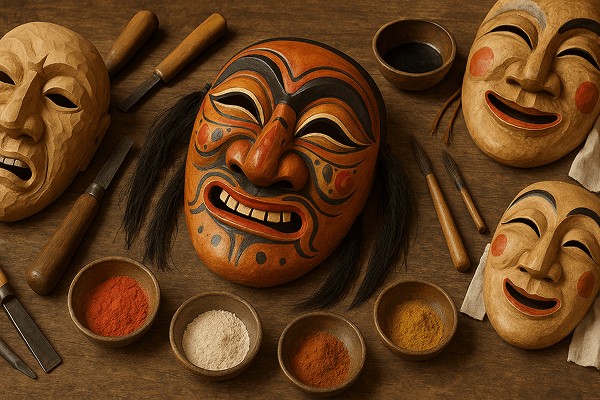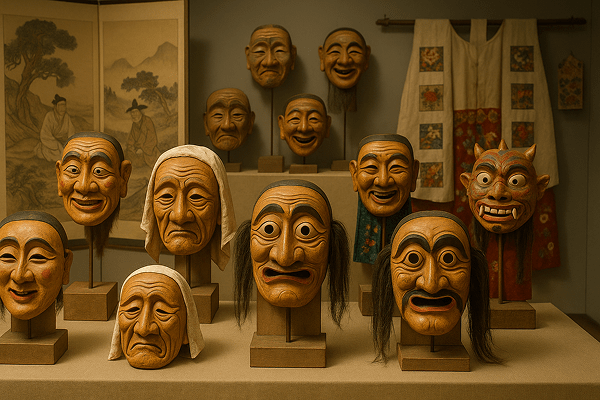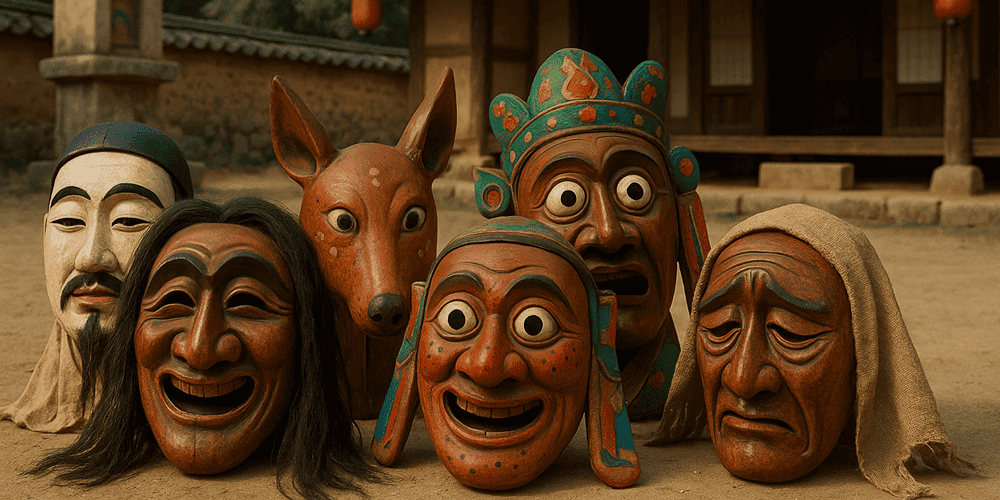Byeolsin Masks are among the most intriguing and culturally rich traditional masks of Korea, especially renowned in the context of ritualistic and theatrical performances. Associated primarily with the Byeolsin-gut shamanic ceremonies in the coastal regions of Korea, particularly in Gyeongsangnam-do province, these masks are celebrated for their distinctive expressions and spiritual significance. Byeolsin Masks are typically carved from wood, often painted in vivid colors, and are characterized by exaggerated facial features such as wide eyes, pronounced noses, and expressive mouths. They often depict a range of characters, from deities and spirits to animals and comic figures, making each mask unique. The tradition of Byeolsin Mask-making and performance is believed to have originated in the late Goryeo or early Joseon period (circa 14th–15th centuries), deeply embedding these masks in Korea’s historical and ritual landscape.
Historical Origins: The Evolution of Byeolsin Masks
The origins of Byeolsin Masks are closely tied to the development of shamanistic practices in coastal Korean villages. The word “byeolsin” (별신) translates as “special spirit” or “special god,” reflecting the mask’s role in mediating between the human and spirit worlds. Historical records suggest that Byeolsin-gut rituals, in which these masks are prominently featured, date back several centuries, serving as a means to appease local deities, ensure community well-being, and drive away evil spirits. Over time, the design and function of Byeolsin Masks have evolved, influenced by local legends, changing religious practices, and the integration of folk theatre. Notable artifacts and references to Byeolsin Masks can be found in historical texts and temple art, demonstrating their long-standing presence in Korean culture. The etymology and transformation of Byeolsin Masks set them apart from other Korean mask traditions, such as Tal Masks, which are also essential elements of the country’s masking heritage.
Cultural Significance and Symbolism: Spiritual and Social Roles
Byeolsin Masks hold profound spiritual and cultural significance in their native regions. In the context of the Byeolsin-gut, the masks are believed to embody the spirits of gods, ancestors, and mythical beings, serving as powerful tools for shamanic communication. Wearing a Byeolsin Mask during a ceremony is thought to invoke the presence of the depicted spirit, allowing the wearer to channel its energy and fulfill ritual objectives. These masks are also used to portray human vices and virtues, offering moral lessons and communal entertainment. Myths and legends associated with Byeolsin Masks often speak of their ability to protect villages from disaster, ensure bountiful harvests, and restore social harmony. Socially, Byeolsin Mask performances bring communities together during festivals, celebrations, and periods of hardship, reinforcing shared values and cultural identity.
Materials and Craftsmanship: Traditional Techniques and Artistic Diversity
The creation of Byeolsin Masks is a meticulous craft, typically involving the use of lightweight woods such as alder or paulownia. Artisans begin by carving the basic shape of the mask, carefully exaggerating facial features to convey the intended character or spirit. The surface is then smoothed, painted with natural pigments, and sometimes adorned with horsehair, fabric, or metal accents for additional effect. Tools such as chisels, knives, and brushes are essential in the mask-making process. Regional differences in craftsmanship are evident, with some areas favoring more abstract designs and others opting for naturalistic details. Color symbolism plays a vital role: red may signify power or protection, black denotes mystery or the unknown, and white is associated with purity or the divine. Decorative motifs often reflect local myths, beliefs, and environmental influences.

Functions and Use: Ritual, Theatre, and Community Life
Byeolsin Masks are primarily used in ritual and ceremonial contexts, most notably in the Byeolsin-gut shamanic rites, which are performed to honor local deities, drive away misfortune, and promote collective happiness. During these ceremonies, masked dancers enact stories, interact with the audience, and perform exorcisms. Beyond ritual, Byeolsin Masks have found a place in folk theatre and seasonal festivals, where they are used to entertain, educate, and unite communities. Over the centuries, the use of Byeolsin Masks has adapted to changing social and religious landscapes, with modern applications including cultural performances, museum exhibitions, and educational programs. The enduring relevance of Byeolsin Masks mirrors the ongoing popularity of other Korean mask traditions, including the well-known Tal Masks.
Regional Variations: Diversity Across Korea
While Byeolsin Masks are most strongly associated with the coastal regions of Gyeongsangnam-do, variations exist across different villages and communities. Each locality may have its own set of characters, stylistic preferences, and ritual functions, resulting in a rich tapestry of mask designs and traditions. Some regions emphasize humor and satire, while others focus on spiritual gravitas or ancestral reverence. When compared to other masking traditions in Korea, such as the Hahoe or Yangju masks, Byeolsin Masks demonstrate unique artistic and functional diversity. The differences and similarities between Byeolsin Masks and related traditions highlight the syncretic nature of Korean folk culture.
Famous Examples and Collections: Where to See Byeolsin Masks
Several notable Byeolsin Masks are preserved in major museums, including the National Folk Museum of Korea and the Gyeongnam Provincial Museum. These institutions display a variety of masks, costumes, and ritual artifacts, offering a window into the world of Korean shamanism and folk performance. Historical finds, such as centuries-old masks uncovered in temple sites or private collections, provide valuable insights into the evolution of Byeolsin Mask art. For enthusiasts and collectors, both public exhibitions and reputable online galleries like toddmasks.com serve as excellent resources for learning about and acquiring authentic Byeolsin Masks.

Influence on Art and Culture: Byeolsin Masks in Modern Creativity
The influence of Byeolsin Masks extends beyond ritual and theatre, impacting a wide array of artistic and cultural expressions in Korea. Their bold forms and expressive features inspire contemporary painters, sculptors, and designers, who reinterpret traditional motifs in new media and styles. Byeolsin Masks appear in literature, cinema, and popular culture, symbolizing themes of transformation, resilience, and community. In modern fashion and stage design, mask imagery is used to evoke heritage and creativity. The preservation and celebration of Byeolsin Masks play a crucial role in sustaining Korean cultural identity, echoing the continued relevance of Tal Masks in both traditional and contemporary settings.
Modern Status and Preservation: Keeping the Tradition Alive
Today, the tradition of Byeolsin Mask-making and performance is upheld by dedicated artisans, cultural organizations, and local communities. Master craftsmen continue to teach traditional techniques through workshops, apprenticeships, and educational programs, ensuring the survival of this unique heritage. Innovative adaptations, such as the use of new materials or digital design, complement established practices without sacrificing authenticity. Annual festivals, museum exhibitions, and masterclasses foster public appreciation and participation, helping to transmit the ritual and artistic value of Byeolsin Masks to future generations.
Collecting and Acquisition: The Market for Byeolsin Masks
The market for Byeolsin Masks includes both antique artifacts and contemporary reproductions, with prices varying according to age, provenance, craftsmanship, and ritual significance. Authentic Byeolsin Masks can be found in specialized galleries, museum shops, and online platforms such as toddmasks.com. When collecting, it is important to assess the mask’s origin, materials, and documentation, and to consider ethical concerns regarding the acquisition and sale of cultural artifacts. Supporting living artisans and cultural preservation initiatives ensures that the tradition continues to thrive in a respectful and sustainable manner.
